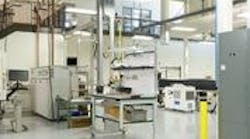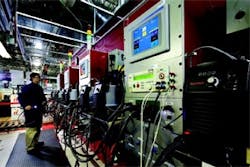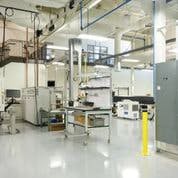In March, Hypertherm, a U.S.-based manufacturer of advanced cutting systems, celebrated the grand opening of a new 160,000 sq ft manufacturing facility in Lebanon, New Hampshire. The additional manufacturing space is expected to facilitate the creation of up to 500 new jobs, including advanced machinist and engineering positions.
Hypertherm designs and manufactures advanced cutting products for use in industries as diverse as shipbuilding, clothing manufacturing, and automotive repair. Its product line includes handheld and CNC systems and consumables, with cutting heads that range from steel-cutting plasma torches to fiber-cutting laser and waterjet equipment.
New Hampshire Governor Maggie Hassan said, following the ribbon cutting ceremony, “I applaud Hypertherm for being a true corporate citizen and a great example of the innovation and ingenuity that exists all throughout the Granite State.”
Effectiveness and efficiency
Evan Smith, Hypertherm president, says exciting developments in the new facility include “an open concept plan with mixed office and manufacturing use. The new plant is expected to receive LEED Silver certification from the U.S. Green Building Council. It is very clean, with lots of windows and skylights to bring in natural light. It contains advanced recycling and filtration systems that help us reduce our costs while improving the performance of our machines,” he says.
“Many of Hypertherm’s buildings are OSHA VPP (voluntary protection program) certified for safety,” says Smith. “Our hope is this building will also be VPP certified. The building is still too new to undergo the certification program.”
Corporate citizenship
“This building contains advanced recycling and filtration systems, pervious pavement, bridges, rain gardens, and solar reflecting roofs,” says Smith. “The first challenge was siting our building in the most sustainable way so that we left the nearby wetlands untouched and took full advantage of the natural beauty of this area. This is a decision you really only have one opportunity to get right, which is why it’s important to the LEED program. Our building is very long and narrow, our paths and parking lots have some beautiful meandering lines, and getting to the building often requires crossing a specially designed pedestrian bridge that is corkscrewed into the ground to leave it barely affected.” This was done to protect the land in its untouched, natural state.
A state-of-the-art building management system turns the heat down, the cooling up, and the lights off when and where needed. “This system saves us from requiring as much energy and saves us money,” explains Smith. “This is one of the decisions that required more upfront investment but was made with the long-term in mind. It will allow us to operate our building for decades at a much reduced impact and cost level.”
All of the Hypertherm facility’s energy is from Green-e certified renewable sources, focusing on solar and wind energy sources. “We can’t generate it ourselves on-site right now due to zoning and wetlands issues, but have chosen to partner with third-party verified experts in the field,” says Smith.
Hypertherm also was able to use its products in the construction of its own building. “Plasma is a perfect tool to use in cutting and preparing structural steel,” explains Smith. “All of the notches, bevels, slots, copes, and bolt holes were cut with an HPR machine, saving time and money. We also sourced the steel for our building with the highest recycled content we could find. Some mills were able to provide us with 100% recycled steel and others were close, giving us an average 77% recycled content in our structural steel.” Sourcing high recycled content is important within the LEED system in order to reduce the use of natural resources.
“The building was designed with the comfort and safety of our associates in mind,” says Smith. “It contains abundance of natural light across our production floor and in all work areas. That’s due to the 45 skylights and 142 windows in the building. The facility also contains a fitness center available to all of our associates 24 hours a day. Wellness is a key focus for us, including our on-site medical staff. So, when it came to finishing the building, we used only low or no VOC paints, coatings, glues, and fibers to keep the air clean. We also installed an air ventilation system that increases outdoor air ventilation over 30% to that of conventional buildings.”
Hypertherm used woods certified by the Forest Stewardship Council in the building’s construction. “We also set up a robust recycling system from the first day of construction and carry that forward today,” says Smith. “We have a goal of becoming a zero-landfill-waste organization by 2020. That means that we’ll be sending none of our trash to a landfill by then. We have waste streams set up for general recycling, as well as composting. Our key focus is to prevent waste from even coming in here. We do that by working with our suppliers on a returnable, reusable packaging solutions as well as always being vigilant about what we’re using and reusing.”
One of the potential problems of building a big facility is that you get in the way of nature, warns Smith. “We designed elements into this building to emulate or assist nature as much as possible,” he explains. “As you look out the windows, you can see our solar-reflecting white roof. The entire roof is white and lowers the heat-island effect of the building, saving on our cooling load and creating fewer disturbances for local habitat and wildlife. Dark-roofed cities can increase ambient temperature by 15 °F. We also have designed rainwater-runoff management throughout our property. In open nature rain falls and then seeps into the ground. Our building is getting in the way of that. The first thing we did was lay down pervious pavement in our parking lots so rain will naturally seep through them. We are also funneling water off our roof down to drains emptying into rain gardens surrounding our buildings. Those rain gardens can store water and slowly release them back into the wetlands. We also went an even further step and installed large underground water storage tanks under our truck area that will hold sudden waterfall and then slowly release it back into the ground, preventing flash floods and runoff.”
Clearly, the innovation that provided the foundation of Hypertherm is carried through the safety and ecology planning of the company’s future. By planning for corporate responsibility, the firm believes it was able to accomplish these goals with little to negative long-term cost.




